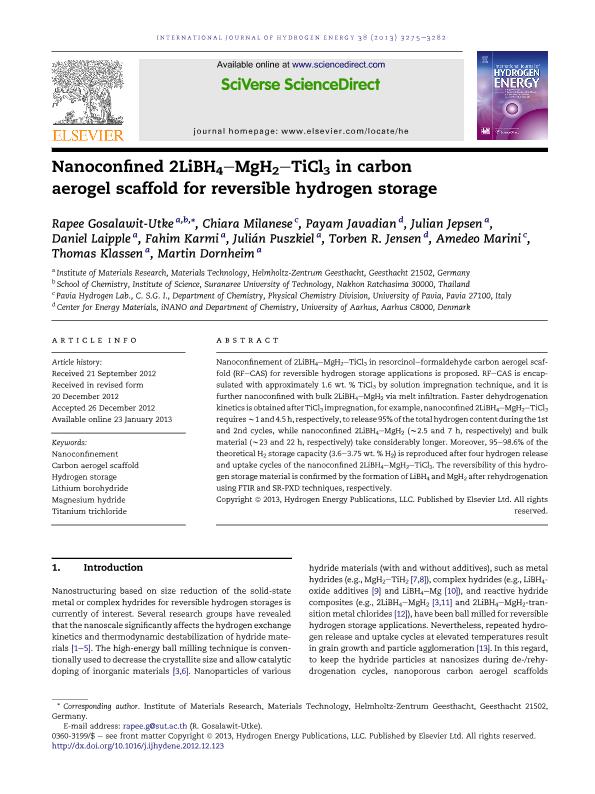Artículo
Nanoconfined 2LiBH4eMgH2eTiCl3 in carbon aerogel scaffold for reversible hydrogen storage
Gosalawit Utke, Rapee; Milanese, Chiara; Javadian, Payam; Jepsen, Julian; Laipple, Daniel; Karmi, Fahim; Puszkiel, Julián Atilio ; Jensen, Torben; Marini, Amedeo; Klassen, Thomas; Dornheim, Martin
; Jensen, Torben; Marini, Amedeo; Klassen, Thomas; Dornheim, Martin
 ; Jensen, Torben; Marini, Amedeo; Klassen, Thomas; Dornheim, Martin
; Jensen, Torben; Marini, Amedeo; Klassen, Thomas; Dornheim, Martin
Fecha de publicación:
03/2013
Editorial:
Elsevier
Revista:
International Journal Of Hydrogen Energy
ISSN:
0360-3199
Idioma:
Inglés
Tipo de recurso:
Artículo publicado
Clasificación temática:
Resumen
Nanoconfinement of 2LiBH4–MgH2–TiCl3 in resorcinol–formaldehyde carbon aerogel scaffold (RF–CAS) for reversible hydrogen storage applications is proposed. RF–CAS is encapsulated with approximately 1.6 wt. % TiCl3 by solution impregnation technique, and it is further nanoconfined with bulk 2LiBH4–MgH2 via melt infiltration. Faster dehydrogenation kinetics is obtained after TiCl3 impregnation, for example, nanoconfined 2LiBH4–MgH2–TiCl3 requires ∼1 and 4.5 h, respectively, to release 95% of the total hydrogen content during the 1st and 2nd cycles, while nanoconfined 2LiBH4–MgH2 (∼2.5 and 7 h, respectively) and bulk material (∼23 and 22 h, respectively) take considerably longer. Moreover, 95–98.6% of the theoretical H2 storage capacity (3.6–3.75 wt. % H2) is reproduced after four hydrogen release and uptake cycles of the nanoconfined 2LiBH4–MgH2–TiCl3. The reversibility of this hydrogen storage material is confirmed by the formation of LiBH4 and MgH2 after rehydrogenation using FTIR and SR-PXD techniques, respectively.
Archivos asociados
Licencia
Identificadores
Colecciones
Articulos(CCT - PATAGONIA NORTE)
Articulos de CTRO.CIENTIFICO TECNOL.CONICET - PATAGONIA NORTE
Articulos de CTRO.CIENTIFICO TECNOL.CONICET - PATAGONIA NORTE
Citación
Gosalawit Utke, Rapee; Milanese, Chiara; Javadian, Payam; Jepsen, Julian; Laipple, Daniel; et al.; Nanoconfined 2LiBH4eMgH2eTiCl3 in carbon aerogel scaffold for reversible hydrogen storage; Elsevier; International Journal Of Hydrogen Energy; 38; 8; 3-2013; 3275-3282
Compartir
Altmétricas



